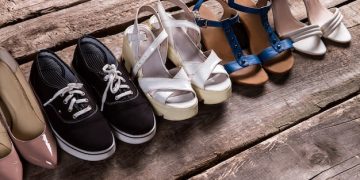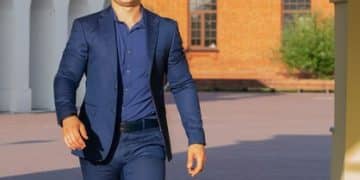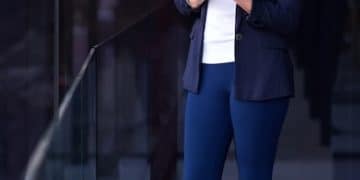Ultimate Shoe Guide: Perfect Footwear for Every Outfit & Occasion
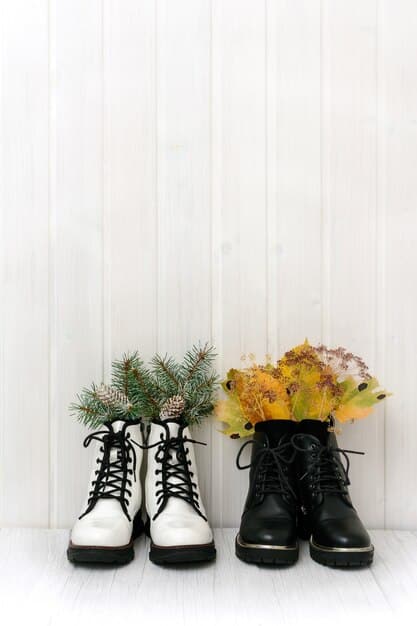
Finding the perfect footwear for any outfit and occasion involves a thoughtful consideration of style, comfort, and functionality, ensuring your shoes complement your attire while suiting the demands of the event, from casual outings to formal gatherings.
Stepping out in style begins from the ground up, and choosing the right pair of shoes can transform an entire ensemble. This comprehensive resource, The Ultimate Shoe Guide: Finding the Perfect Footwear for Every Outfit and Occasion, is designed to demystify the art of selecting appropriate footwear, ensuring you step out with confidence and comfort, no matter where you’re headed.
Understanding the Foundation: Comfort and Fit First
Before delving into aesthetics and trends, it’s crucial to acknowledge that the foundation of any great shoe choice lies in comfort and a proper fit. Shoes that pinch, rub, or offer inadequate support can transform a joyful event into a painful ordeal, impacting not only your feet but your overall well-being and confidence. Prioritizing comfort ensures longevity of wear and protects foot health.
Many individuals overlook the importance of having their feet professionally measured periodically, assuming their shoe size remains static. However, factors such as age, pregnancy, and weight fluctuations can alter foot size and shape. A shoe that fits correctly should not feel tight in any area, allowing for natural toe movement without slipping at the heel.
The Anatomy of a Well-Fitted Shoe
Understanding the basic components of a shoe can help you identify what truly constitutes a good fit. The toe box should be wide enough to allow toes to wiggle freely, preventing common issues like bunions or hammertoes. The instep, the top part of your foot, should feel secure but not constricted by the shoe’s upper material.
- Arch Support: Proper arch support is vital for distributing pressure evenly across the foot, reducing strain on the arches, heels, and ankles. This is particularly important for those who spend long hours on their feet.
- Heel Counter: The heel counter is the back part of the shoe that cups the heel. A firm heel counter provides stability and prevents the foot from rolling inward or outward excessively.
- Outsole: The outsole offers traction and durability. Its flexibility should allow for natural foot movement during walking, while adequate cushioning absorbs impact.
Beyond fit, the materials used in shoe construction significantly influence comfort. Natural materials like leather and suede allow feet to breathe, minimizing sweat and odor. Synthetic materials can vary greatly in quality; some mimic natural properties well, while others may cause excessive sweating or discomfort. Always consider the material in relation to the climate and typical duration of wear. Ultimately, a shoe’s primary purpose, regardless of its style, is to protect and support your feet. Investing time in finding shoes that fit properly and feel comfortable will pay dividends in your long-term foot health and overall comfort.
Decoding Dress Codes: Matching Footwear to Formality
Navigating the nuances of dress codes often presents a challenge, especially when it comes to selecting appropriate footwear. The right shoes can elevate an outfit, conveying respect for the occasion and an understanding of social norms. Conversely, an ill-suited pair can undermine an otherwise impeccable ensemble. Understanding different formality levels is key.
For highly formal events, such as black-tie galas or sophisticated weddings, traditional choices are usually the safest. Men typically opt for polished leather oxfords or patent leather dress shoes, which exude elegance and sophistication. Women’s choices often include classic pumps, elegant block heels, or refined stilettos, often in neutral tones or highly polished finishes that complement formal evening wear. The aim is to achieve a sleek, uninterrupted silhouette.
Casual and Smart Casual Footwear Essentials
In less formal settings, a greater degree of flexibility is permitted, but decorum still applies. “Smart casual” strikes a balance between relaxed and polished, allowing for more personality. For men, this might mean loafers, clean leather sneakers, or stylish chukka boots. Women can choose from fashionable flats, espadrilles, stylish ankle boots, or even tasteful open-toed sandals if the weather permits and the setting is appropriate.
- Daytime Events: Think about comfort and practicality. Loafers, ballet flats, and stylish sneakers are excellent for daily wear or casual meet-ups.
- Business Casual: Brogues, dressier loafers, and polished Chelsea boots work well for men. For women, moderate heels, elegant flats, or sophisticated ankle boots are ideal.
- Weekend Wear: Sneakers, fashion trainers, and sandals offer ultimate comfort and versatility for leisure activities.
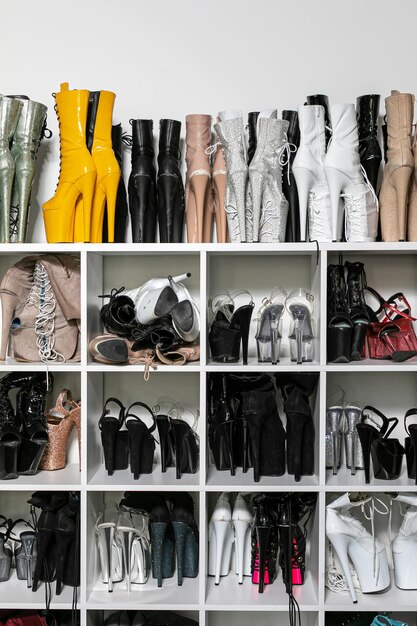
The material and condition of your shoes are just as important as their style. Even the most casual footwear should be clean, well-maintained, and in good repair. Scuffed shoes or those with worn soles can detract from an otherwise well-put-together look. Consider the venue’s flooring and the amount of walking or standing involved when making your selection. A successful shoe choice for any dress code is one that combines aesthetic appeal with practical considerations, ensuring both style and comfort are met.
Seasonal Sensibility: Footwear for Every Climate
The changing seasons bring diverse weather conditions, necessitating a thoughtful rotation of footwear. Adapting your shoe choices to the climate is not merely about staying comfortable; it’s also about protecting your feet from the elements and ensuring the longevity of your shoes. Ignoring seasonal sensibilities can lead to unnecessary discomfort or damage to your treasured footwear collection.
As temperatures rise, lightweight, breathable options become paramount. Summer footwear prioritizes ventilation and minimal coverage to keep feet cool. Sandals, espadrilles, and open-toed heels are popular choices, offering both style and airiness. Materials like canvas, linen, and raffia are common for their breathable qualities. However, it’s important to remember that not all summer events call for open shoes; enclosed styles made from breathable fabrics or perforated leather can still be appropriate for more formal summer gatherings.
Navigating Colder Months and Transitional Weather
When autumn leaves begin to fall, so too should the weight of your footwear change. Boots become indispensable, offering warmth and protection from cooler temperatures and potential rain. Ankle boots, knee-high boots, and riding boots provide versatile options that pair well with anything from jeans to dresses. For men, chukka boots, desert boots, and durable leather sneakers gain prominence. The focus shifts to closed-toe styles and sturdy materials that can withstand more inclement weather.
- Winter Warmth: Insulated boots with good traction are essential for cold, snowy, or icy conditions. Look for waterproof materials like Gore-Tex or treated leather.
- Spring Showers: Water-resistant materials are key. Rain boots, waterproof loafers, and leather or coated canvas sneakers are practical choices that stylishly navigate spring’s unpredictable weather.
- Material Matters: Opt for rich, durable materials in cooler months, such as suede, nubuck, or full-grain leather, which offer better insulation and protection.
Beyond comfort and protection, seasonal footwear also plays a role in fashion. Darker, richer colors and heavier textures are often favored in fall and winter, while brighter colors and lighter materials dominate spring and summer. Transitional periods, like early spring or late autumn, may call for versatile options that bridge the gap, such as loafers, closed-toe flats, or lighter boots that can adapt to fluctuating temperatures. By carefully considering the weather and selecting appropriate footwear, you can ensure both comfort and style year-round, while also preserving the life of your shoe collection.
The Versatility Quotient: Building a Core Shoe Wardrobe
Building a versatile shoe wardrobe is an art of thoughtful selection, focusing on pieces that can be mixed and matched across various outfits and occasions. The goal is not to accumulate a vast collection, but rather to own a curated selection of high-quality shoes that serve multiple purposes, maximizing their utility and ensuring you always have the right pair on hand. This approach saves money and wardrobe space, promoting sustainable fashion choices.
At the core of any versatile wardrobe are a few key staples. For women, this often includes a classic pair of neutral pumps (think black or nude), comfortable yet stylish flats, a versatile pair of ankle boots, and chic sneakers. These four categories alone can cover a surprising breadth of situations, from formal events to casual errands. The versatility largely comes from their timeless design and neutral color palettes, which allow them to seamlessly integrate with diverse clothing styles.
Essential Staples for Every Man’s Collection
Men’s versatile shoe wardrobes also rely on foundational pieces. A pair of well-polished leather oxfords or derbies is indispensable for business or formal settings. Loafers offer a smart-casual alternative that bridges the gap between formal and relaxed. A good quality pair of clean, minimal sneakers provides comfort and a contemporary edge for casual outings. Lastly, a sturdy pair of work boots or versatile chukkas can serve practical needs while maintaining style.
- Neutral Colors: Black, brown, navy, white, and nude are your allies. They pair with almost any color or pattern in your clothing.
- Classic Designs: Opt for timeless styles over fleeting trends. Classic silhouettes often have a longer shelf life and adapt better to evolving fashion.
- Quality Over Quantity: Investing in fewer, higher-quality pairs means they will last longer, look better, and often be more comfortable due to superior materials and craftsmanship.
When selecting versatile shoes, consider materials that offer durability and adapt well to various settings. Leather is often a top choice due to its longevity, ability to be polished, and aesthetic appeal. Suede offers a softer, more casual elegance. Always think about how a new pair will integrate with your existing wardrobe before making a purchase. A truly versatile shoe is one that you can wear frequently, with different outfits, and feel confident in its suitability for diverse occasions. Building such a collection is about strategic choices rather than impulsive buys, creating a foundation that serves you well time and again.
Current Trends vs. Timeless Classics: Striking a Balance
The world of footwear, like fashion as a whole, is a dynamic interplay between fleeting trends and enduring classics. While it’s tempting to chase every new style that emerges from the runways, a truly sophisticated approach involves understanding how to strike a balance between integrating current trends and relying on the steadfast appeal of timeless designs. This strategy ensures your wardrobe remains relevant without becoming obsolete with each passing season.
Timeless classic shoes are the workhorses of any wardrobe. They possess an inherent elegance and versatility that transcends seasonal fads. Think of the classic black pump, the leather oxford, the simple ballet flat, or the white minimal sneaker. These styles have proven their longevity due to their clean lines, adaptability, and ability to complement a wide range of outfits. Investing in high-quality versions of these classics provides a stable foundation for your footwear collection, ensuring you always have appropriate options for any occasion.
Embracing Trends Thoughtfully
While classics provide stability, trends offer an opportunity to express individuality and keep your style fresh. However, rather than adopting every trend indiscriminately, a more discerning approach is advisable. Consider how a particular trend aligns with your personal style and existing wardrobe. A subtle nod to a trend, such as incorporating a trendy color or a specific design detail, can be more effective than a full embrace, especially for shoes that are often visible and defining elements of an outfit.
- Accessorize with Trends: If a trend feels too bold for a staple shoe, consider incorporating it through footwear accessories like elaborate laces, embellished straps, or statement buckles.
- Cost-Benefit Analysis: For highly trendy shoes, consider investing less. Budget-friendly options allow you to experiment without significant financial commitment, as these styles may quickly fall out of favor.
- Personal Relevance: A trend should resonate with your lifestyle and comfort level. If a trendy shoe is uncomfortable or impractical for your daily activities, it’s likely not a worthwhile addition.
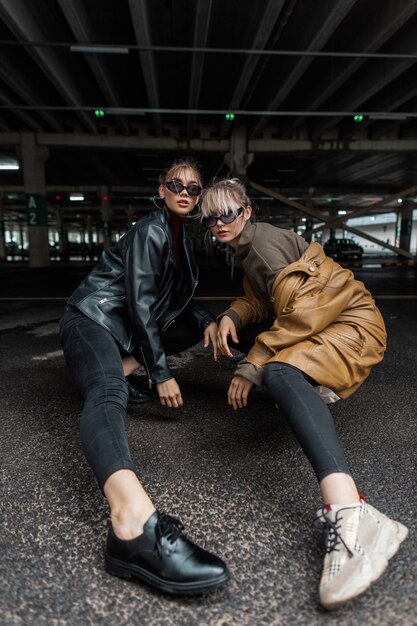
The goal is to build a shoe wardrobe that feels both current and enduring. This means having a strong base of classic pieces that provide reliability and sophistication, augmented by a few carefully selected trendy items that inject personality and keep your look contemporary. This balanced approach not only ensures you’re always well-shod but also allows for a more sustainable and economically sound approach to fashion, preventing the rapid turnover of items in your closet.
Footwear Care and Maintenance: Extending the Life of Your Shoes
The longevity and appearance of your shoes are directly correlated with the care and maintenance they receive. Neglecting proper shoe care can lead to premature wear, damage, and a diminished aesthetic, ultimately costing more in replacements. Investing time in routine cleaning, conditioning, and protection not only preserves your footwear but also reflects a commitment to personal presentation.
Regular cleaning is the cornerstone of shoe maintenance. For leather shoes, this typically involves wiping away dirt and dust with a soft brush or damp cloth after each wear. Depending on the type of leather, a specialized cleaner may be needed to remove stubborn marks. Suede and nubuck require specific brushes to lift dirt and restore the nap, avoiding water which can stain these materials. Canvas and synthetic shoes can often be spot-cleaned with mild soap and water.
Protection and Storage Essentials
Beyond cleaning, protecting your shoes from the elements is crucial. Waterproofing sprays are highly recommended for most materials, especially leather and suede, providing a barrier against rain and spills. This preventative measure can significantly reduce damage. For shoes made of delicate materials, consider specialized protective treatments that guard against stains.
- Shoe Trees: Using shoe trees, particularly cedar ones, helps maintain the shoe’s original shape, absorbs moisture, and prevents creasing.
- Alternating Wear: Avoid wearing the same pair of shoes every day. Allowing shoes to air out and recover for at least 24 hours between wears helps dissipate moisture and extends their life.
- Proper Storage: Store shoes in a cool, dry place away from direct sunlight. Use shoe bags to protect them from dust and scratches, especially for delicate or infrequently worn pairs.
Routine conditioning is also vital for leather shoes to prevent them from drying out and cracking. Leather conditioners moisturize the material, keeping it supple and resilient. Polishing not only enhances shine but also provides a protective layer. For scuffed heels or worn soles, timely repairs by a professional cobbler can salvage a pair of shoes that might otherwise be discarded. Understanding the specific needs of different shoe materials and consistently applying these care practices will ensure your footwear collection remains in pristine condition, ready to complement any outfit for years to come. Proper care is an investment that pays off in durability and continued style.
Ethical and Sustainable Footwear Choices
In an increasingly conscious world, the choices we make as consumers extend beyond personal style and comfort to encompass environmental and ethical considerations. The footwear industry, historically known for its significant ecological footprint and labor practices, is undergoing a transformation. Opting for ethical and sustainable footwear means supporting brands committed to responsible sourcing, fair labor, and minimizing environmental impact through innovative materials and production methods. This shift allows consumers to align their purchasing power with their values.
Sustainable footwear often focuses on materials that are either recycled, renewable, or have a lower environmental impact during production. This includes organic cotton, recycled plastics, natural rubber, cork, and innovative plant-based leathers such as pineapple leather or mushroom leather. These materials aim to reduce reliance on virgin resources and lessen waste, offering alternatives to traditional synthetic and animal-derived components. Brands prioritizing sustainability will also often detail their material origins and production processes transparently.
Fair Labor and Circular Economy Principles
Ethical footwear production emphasizes fair wages, safe working conditions, and respect for human rights throughout the supply chain. This means avoiding sweatshops and child labor, and ensuring that workers are treated with dignity. Certifications from organizations like Fair Trade can help consumers identify brands committed to these principles. Transparency in supply chains, from raw material to finished product, is a hallmark of truly ethical companies.
- Durability and Longevity: A key aspect of sustainability is creating products that last. Durable shoes reduce the need for frequent replacements, lowering overall consumption and waste.
- Repairability: Sustainable brands often design shoes that can be easily repaired, further extending their lifespan and reducing consumer waste.
- End-of-Life Solutions: Some companies offer take-back programs for worn-out shoes, ensuring components are recycled or upcycled rather than ending up in landfills.
Embracing a circular economy approach in footwear means designing out waste and pollution, keeping products and materials in use, and regenerating natural systems. This can translate to brands using closed-loop manufacturing processes where materials are continuously reused. While truly sustainable and ethical footwear might come with a higher upfront cost, it represents a long-term investment in both quality and responsibility. Choosing such footwear is a powerful statement, demonstrating a commitment to environmental stewardship and social justice within the fashion industry, contributing to a more sustainable future one step at a time.
Personal Style: Making Your Shoes Reflect You
Beyond the practicalities of comfort, occasion, and season, footwear serves as a powerful medium for personal expression. Your shoes are often the punctuation mark on an outfit, capable of signaling your personality, mood, and even your creative inclinations. Developing a keen sense of how to choose shoes that reflect your unique personal style allows you to move beyond mere appropriateness and truly express who you are. This involves understanding your aesthetic preferences and how footwear can amplify them.
Consider the overarching theme of your wardrobe. Do you gravitate towards classic, minimalist lines, or are you drawn to bold patterns and vibrant colors? Are you a maximalist who loves intricate details, or do you prefer understated elegance? Your footwear choices should ideally harmonize with these broader stylistic tendencies. For instance, if your clothing is predominantly classic, a modern twist on a traditional shoe, such as an oxford in an unexpected color or texture, can introduce an element of personal flair without clashing.
Experimenting with Embellishments and Details
The subtle details on a shoe can often speak volumes about your personal style. Embellishments such as buckles, studs, bows, or unique stitching can transform a basic silhouette into a statement piece. The choice of material also plays a significant role; a patent leather pump conveys a different message than a suede one, even if they share the same shape. Similarly, the color of your shoes can dramatically alter an outfit’s perception.
- Statement Pieces: Don’t shy away from owning a few pairs of “statement shoes” that are purely for personal enjoyment and making an impression, even if they see less frequent wear.
- Comfort as Persona: If your personal style leans towards comfort and practicality, embrace stylish yet ergonomic designs like high-fashion sneakers, comfortable flats, or well-designed walking boots.
- Color and Texture Play: Use shoes to introduce a pop of color or an interesting texture to an otherwise simple outfit, turning footwear into a focal point.
Ultimately, personal style is an evolving journey, and your shoe choices can grow with you. Don’t be afraid to experiment, try new styles, and even break a few conventional rules if it feels right for you. The most stylish people are often those who wear their choices with confidence and authenticity. When your footwear authentically reflects your personality, it doesn’t just complete an outfit; it tells a story, making every step a statement of who you are.
| Key Aspect | Brief Description |
|---|---|
| 👟 Fit & Comfort | Prioritize proper sizing and materials for foot health and long-term wearability. |
| 👗 Occasion Matching | Align footwear with formality of event (formal, casual, business) for appropriate style. |
| ☔ Seasonal Adaptability | Choose shoes that offer protection and comfort suitable for the current climate. |
| ✨ Personal Expression | Use shoes to showcase your unique personality and aesthetic preferences. |
Frequently Asked Questions About Footwear Selection
Proper shoe fit is paramount for both comfort and long-term foot health. Ill-fitting shoes can lead to various issues, including bunions, hammertoes, blisters, and general discomfort. It’s recommended to measure your feet regularly, as size can change over time, and always try on shoes towards the end of the day when feet are slightly swollen.
For a versatile wardrobe, women should consider classic neutral pumps, comfortable flats, versatile ankle boots, and stylish sneakers. Men should aim for polished leather oxfords/derbies, versatile loafers, clean minimal sneakers, and durable boots. These staples cover most occasions and can be easily mixed and matched with various outfits.
Care varies by material. Leather shoes require regular wiping, conditioning, and polishing. Suede needs special brushing and waterproofing sprays. Canvas and synthetic shoes can often be spot-cleaned with mild soap and water. Always use shoe trees to maintain shape and allow shoes to air out between wears to extend their lifespan.
A balanced approach is best. Build a strong foundation with high-quality, timeless classic shoes that offer versatility and longevity. Then, sparingly incorporate current trends through less expensive pieces or subtle details. This strategy keeps your wardrobe relevant and fresh without sacrificing durability or resorting to constant replacments.
Shoes are a crucial element of personal expression, capable of defining or transforming an outfit. They allow you to showcase your personality, from minimalist elegance to bold statements, through color, material, and design. Choosing footwear that truly resonates with your individual aesthetic ensures your entire look is cohesive and authentic.
Conclusion
The journey to finding the perfect footwear is a blend of practical considerations and personal expression. From understanding the immutable importance of comfort and fit to navigating the subtleties of dress codes and seasonal changes, each choice contributes to a cohesive and confident look. By prioritizing quality, thoughtful selection, and consistent care, your shoes become more than just accessories; they are foundational elements of your personal style, ready to carry you through every occasion with grace and assurance. Embracing a mindful approach to footwear not only elevates your wardrobe but also enhances your overall well-being, one perfectly placed step at a time.
